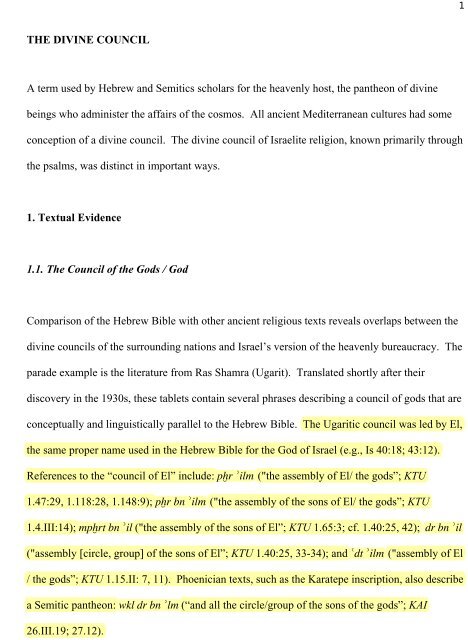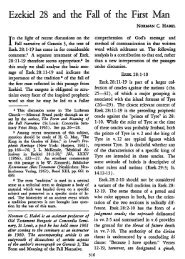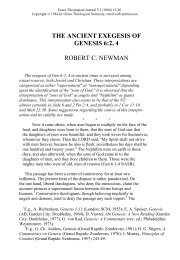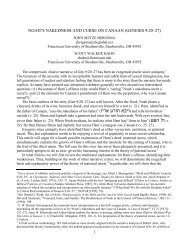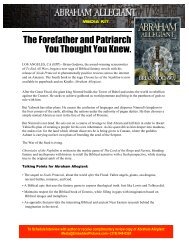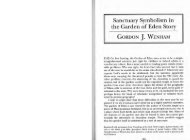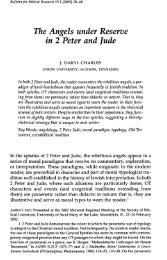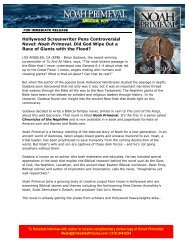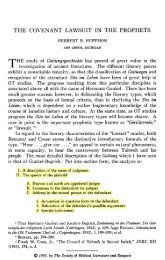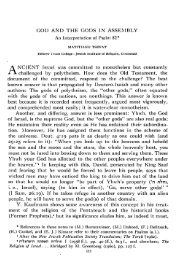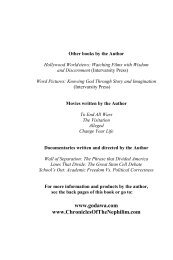Introduction to the Divine Council
Introduction to the Divine Council
Introduction to the Divine Council
You also want an ePaper? Increase the reach of your titles
YUMPU automatically turns print PDFs into web optimized ePapers that Google loves.
1<br />
THE DIVINE COUNCIL<br />
A term used by Hebrew and Semitics scholars for <strong>the</strong> heavenly host, <strong>the</strong> pan<strong>the</strong>on of divine<br />
beings who administer <strong>the</strong> affairs of <strong>the</strong> cosmos. All ancient Mediterranean cultures had some<br />
conception of a divine council. The divine council of Israelite religion, known primarily through<br />
<strong>the</strong> psalms, was distinct in important ways.<br />
1. Textual Evidence<br />
1.1. The <strong>Council</strong> of <strong>the</strong> Gods / God<br />
Comparison of <strong>the</strong> Hebrew Bible with o<strong>the</strong>r ancient religious texts reveals overlaps between <strong>the</strong><br />
divine councils of <strong>the</strong> surrounding nations and Israel’s version of <strong>the</strong> heavenly bureaucracy. The<br />
parade example is <strong>the</strong> literature from Ras Shamra (Ugarit). Translated shortly after <strong>the</strong>ir<br />
discovery in <strong>the</strong> 1930s, <strong>the</strong>se tablets contain several phrases describing a council of gods that are<br />
conceptually and linguistically parallel <strong>to</strong> <strong>the</strong> Hebrew Bible. The Ugaritic council was led by El,<br />
<strong>the</strong> same proper name used in <strong>the</strong> Hebrew Bible for <strong>the</strong> God of Israel (e.g., Is 40:18; 43:12).<br />
References <strong>to</strong> <strong>the</strong> “council of El” include: ph}r )ilm ("<strong>the</strong> assembly of El/ <strong>the</strong> gods”; KTU<br />
1.47:29, 1.118:28, 1.148:9); ph}r bn )ilm ("<strong>the</strong> assembly of <strong>the</strong> sons of El/ <strong>the</strong> gods”; KTU<br />
1.4.III:14); mph}rt bn )il ("<strong>the</strong> assembly of <strong>the</strong> sons of El”; KTU 1.65:3; cf. 1.40:25, 42); dr bn )il<br />
("assembly [circle, group] of <strong>the</strong> sons of El”; KTU 1.40:25, 33-34); and (dt )ilm ("assembly of El<br />
/ <strong>the</strong> gods”; KTU 1.15.II: 7, 11). Phoenician texts, such as <strong>the</strong> Karatepe inscription, also describe<br />
a Semitic pan<strong>the</strong>on: wkl dr bn )lm (“and all <strong>the</strong> circle/group of <strong>the</strong> sons of <strong>the</strong> gods”; KAI<br />
26.III.19; 27.12).
2<br />
The (dt )ilm ("assembly of El / <strong>the</strong> gods”) of Ugaritic texts represents <strong>the</strong> most precise parallel <strong>to</strong><br />
<strong>the</strong> data of <strong>the</strong> Hebrew Bible. Psalm 82:1 uses <strong>the</strong> same expression for <strong>the</strong> council ((dt )ilm),<br />
along with an indisputably plural use of <strong>the</strong> word )e5lo4h|
3<br />
rivers" (mbk nhrm) in <strong>the</strong> "midst of <strong>the</strong> fountains of <strong>the</strong> double-deep" (qrb )apq thmtm). This<br />
well-watered mountain was <strong>the</strong> place of <strong>the</strong> "assembled congregation" (ph}r m(d). El dwelt on<br />
this mountain and, with his council, issued divine decrees from <strong>the</strong> “tents of El” (d;d )il) and his<br />
"tent shrine” (qrs\ ; KTU 1.1.III:23; 1.2.III:5; 1.3.V:20-21; 1.4.IV:22-23; 1.6.I:34-35; 1.17.VI:48).<br />
In <strong>the</strong> Kirta Epic, El and <strong>the</strong> gods live in “tents” ()ahlm) and “tabernacles” (ms\knt; KTU<br />
1.15.3.18-19). The Ugaritic god Baal, <strong>the</strong> deity who oversaw <strong>the</strong> council for El (see below) held<br />
meetings in <strong>the</strong> “heights” (mrym) of Mount S[apa4nu, apparently located in a range of mountains<br />
that included El’s own abode. In Baal's palace in S[apa4nu <strong>the</strong>re were “paved bricks” (lbnt) that<br />
made Baal's house "a house of <strong>the</strong> clearness of lapis lazuli" (bht t[hrm )iqn)um).<br />
These descriptions are present in <strong>the</strong> Hebrew Bible with respect <strong>to</strong> Israel’s God and his council.<br />
Yahweh dwells on mountains (Sinai or Zion; e.g., Ex 34:26; 1 Kings 8:10; Ps 48:1-2). The<br />
Jerusalem temple is said <strong>to</strong> be located in <strong>the</strong> “heights of [yarke5te
4<br />
1.3 The Structure and Bureaucracy of <strong>the</strong> <strong>Divine</strong> <strong>Council</strong><br />
The council at Ugarit apparently had four tiers (Smith, Origins, 41-53). The <strong>to</strong>p tier consisted of<br />
El and his wife Athirat (Asherah). The second tier was <strong>the</strong> domain of <strong>the</strong>ir royal family (“sons<br />
of El”; “princes”). One member of this second tier served as <strong>the</strong> vice regent of El, and was,<br />
despite being under El’s authority, given <strong>the</strong> title “most high” (Wyatt, “Titles,” 419). A third tier<br />
was for “craftsman deities,” while <strong>the</strong> lowest tier was reserved for <strong>the</strong> messengers (ml)km),<br />
essentially servants or staff. The Ugaritic council is at times described as a court with a<br />
prosecu<strong>to</strong>rial figure called <strong>the</strong> sat[an present, whose job was <strong>to</strong> enforce divine legislation and<br />
point out transgression (Handy, “Authorization”).<br />
Evidence for exactly <strong>the</strong> same structures in <strong>the</strong> Israelite council is tenuous. Despite <strong>the</strong> fact that<br />
popular Israelite religion may have unders<strong>to</strong>od Yahweh as having a wife (Asherah; Hess), it<br />
cannot be sustained that <strong>the</strong> religion of <strong>the</strong> prophets and biblical writers contained this element or<br />
that <strong>the</strong> idea was permissible. There is also no real evidence for <strong>the</strong> craftsman tier. However,<br />
<strong>the</strong> role of <strong>the</strong> sat[an, <strong>the</strong> Accuser, is readily apparent (Job 1:6ff.; 2:1ff.). In <strong>the</strong> divine council in<br />
Israelite religion, Yahweh was <strong>the</strong> supreme authority over a divine bureaucracy that included a<br />
second tier of lesser )e5lo4h|
5<br />
same essence as Yahweh but a distinct, second person. This is most plainly seen via <strong>the</strong> Name<br />
<strong>the</strong>ology of <strong>the</strong> Hebrew Bible and <strong>the</strong> so-called “Angel of Yahweh” (cf. Ex 23:20-33 for <strong>the</strong><br />
Angel’s connection <strong>to</strong> <strong>the</strong> Name, <strong>the</strong> essence of Yahweh; Heiser, “<strong>Divine</strong> <strong>Council</strong>,” 34-67).<br />
2. Mono<strong>the</strong>ism in <strong>the</strong> Hebrew Bible and <strong>the</strong> <strong>Divine</strong> <strong>Council</strong><br />
2.1 Biblical Poly<strong>the</strong>ism?<br />
Many scholars have concluded that <strong>the</strong> presence of a divine council in <strong>the</strong> Hebrew Bible means<br />
that Israel’s religion was at one time poly<strong>the</strong>istic (<strong>the</strong>re are many gods) or heno<strong>the</strong>istic (<strong>the</strong>re are<br />
many gods, but one is preferred) and only later evolved <strong>to</strong> mono<strong>the</strong>ism. Poly<strong>the</strong>ism and<br />
monolatrous heno<strong>the</strong>ism both presume “species sameness” among <strong>the</strong> gods. Heno<strong>the</strong>ism in<br />
particular assumes <strong>the</strong> possibility of a power struggle for supremacy in <strong>the</strong> council, where <strong>the</strong><br />
supreme authority could be displaced if ano<strong>the</strong>r god defeats or outwits him. This does not reflect<br />
orthodox Israelite religious belief. The biblical data indicate that orthodox Israelite religion<br />
never considered Yahweh as one among equals or near equals. The biblical writers refer<br />
exclusively <strong>to</strong> Yahweh as “<strong>the</strong> God” (ha4)e5lo4h|
6<br />
29:25; 32:17). Yahweh’s utter uniqueness <strong>to</strong> all o<strong>the</strong>r )e4lo4h|
7<br />
If <strong>the</strong> lesser )e4lo4h|
8<br />
Isaiah 47:8, 10, where Babylon boldly claims, “I am, and <strong>the</strong>re is none else beside me.” The<br />
claim is not that Babylon is <strong>the</strong> only city in <strong>the</strong> world, but that she has no rival.<br />
Some would argue that <strong>the</strong> descriptions of a divine council are merely metaphoric. Metaphoric<br />
language, however, is not based on what a writer’s view of reality excludes. Ra<strong>the</strong>r, <strong>the</strong><br />
metaphor is a means of framing and categorizing something that is part of a writer’s worldview.<br />
When <strong>the</strong> biblical writer asserts, “Who is like you, O Lord, among <strong>the</strong> gods ()e4lo4h|
9<br />
regent of <strong>the</strong> council. This structure reflected Israel’s belief in Yahweh’s on<strong>to</strong>logical uniqueness<br />
as crea<strong>to</strong>r of all things, including <strong>the</strong> o<strong>the</strong>r )e4lo4h|
10<br />
Heaven: The Syro-Palestinian Pan<strong>the</strong>on as Bureaucracy (Winona Lake, IN: Eisenbrauns, 1994);<br />
Michael S. Heiser, "Deuteronomy 32:8 and <strong>the</strong> Sons of God," BibSac 158 (2001): 52-74; idem,<br />
"The <strong>Divine</strong> <strong>Council</strong> in Second Temple Literature," Ph.D. diss., University of Wisconsin-<br />
Madison, 2004; R. S. Hess, “Yahweh and his Asherah? Epigraphic Evidence for Relgious<br />
Pluralism in Old Testament Times,” in One God, One Lord in a World of Religious Pluralism,<br />
ed. A.D. Clarke and B.W. Winter (Cambridge: Tyndale House, 1991) 5-33; Larry W. Hurtado,<br />
One God, One Lord: Early Christian Devotion and Ancient Jewish Mono<strong>the</strong>ism (Philadelphia:<br />
Fortress, 1988); idem, "The Binitarian Shape of Early Christian Worship," in The Jewish Roots<br />
of Chris<strong>to</strong>logical Mono<strong>the</strong>ism, Papers from <strong>the</strong> St. Andrews Conference on <strong>the</strong> His<strong>to</strong>rical<br />
Origins of <strong>the</strong> Worship of Jesus, ed. Carey C. Newman, James R. Davila and Gladys S. Lewis<br />
(SupJSJ 63; Leiden: Brill, 1999) 187-213; E. Theodore Mullen, Jr., The <strong>Divine</strong> <strong>Council</strong> in<br />
Canaanite and Early Hebrew Literature (HSM 24; Chico, CA: Scholars Press, 1980); idem,<br />
“<strong>Divine</strong> Assembly,” ABD 2.214-217; Simon B. Parker, "Sons of (<strong>the</strong>) God(s)," DDD, 794-798;<br />
W. S. Prinsloo, “Psalm 82: Once Again, Gods or Men?” Bib 76:2 (1995): 219-228; Alan F.<br />
Segal, Two Powers in Heaven: Early Rabbinic Reports about Christianity and Gnosticism<br />
(Leiden: Brill, 1977); Chris<strong>to</strong>pher R. Seitz, "The <strong>Divine</strong> <strong>Council</strong>: Temporal Transition and New<br />
Prophecy in <strong>the</strong> Book of Isaiah," JBL 109:2 (1990): 229-247; Mark S. Smith, The Origins of<br />
Biblical Mono<strong>the</strong>ism: Israel's Poly<strong>the</strong>istic Background and <strong>the</strong> Ugaritic Texts (New York:<br />
Oxford University Press, 2001); idem, The Early His<strong>to</strong>ry of God: Yahweh and O<strong>the</strong>r Deities in<br />
Ancient Israel (2nd ed.; Grand Rapids: Eerdmans, 2002); Nicholas Wyatt, “The Titles of <strong>the</strong><br />
Ugaritic S<strong>to</strong>rm God," UF 24 (1992): 403-424.


